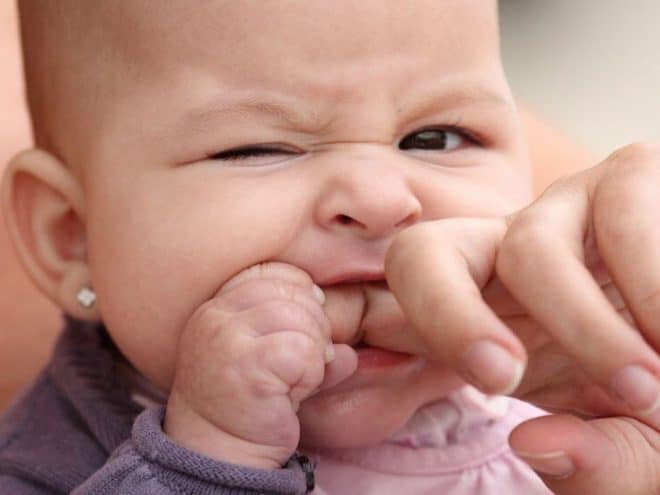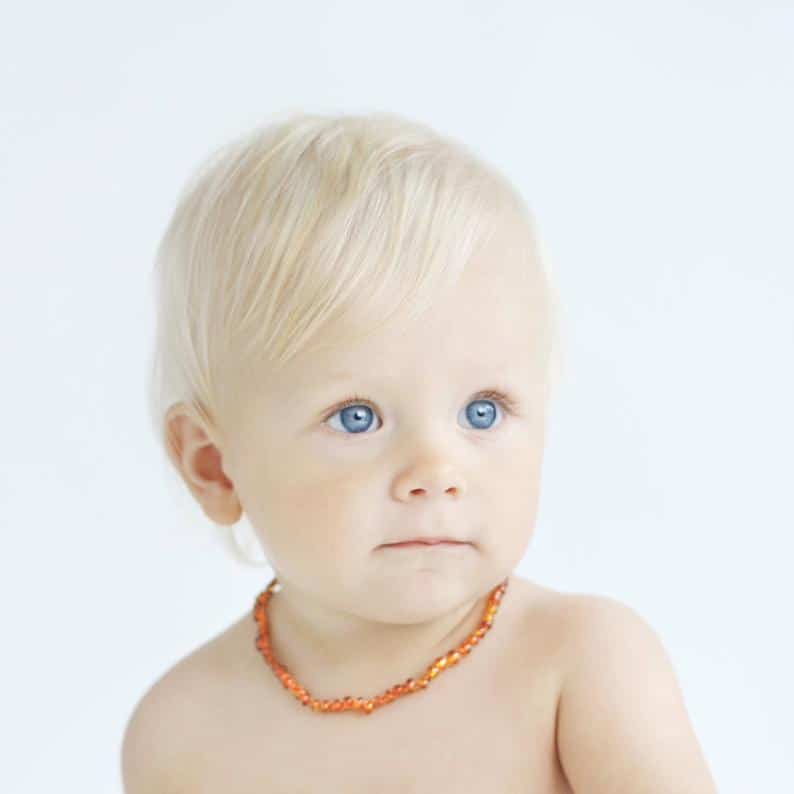How To Survive A Teething Baby
Teething is no fun! Not for you, and not for your baby. This is for sure an uncomfortable time but the more you know about a teething baby, the easier things will be.
Of course, teething can be different for every baby, but here is a survival guide to help you through it. It offers the most frequently asked questions about baby teething symptoms and teething remedies.
The most common teething questions covered in this article are:
- When do babies start teething?
- What do teething gums look like?
- How long does teething last?
- What are the symptoms of teething?
- In what order to baby teeth come in?
- How to soothe a teething baby at night?
- Does teething cause diarrhea?
- How do I choose teethers for my baby?
- Do teething necklaces work?
- What are good teething remedies that actually work?
- Are baltic amber teething necklaces safe?
- Can I breastfeed while my baby is teething?
- Is it normal for babies to eat less while teething?
- Do teething babies poop more?
- What is a teething rash and how do I deal with it?
- Does teething cause fever?
- When do I call my pediatrician?
- When to start brushing baby’s teeth?
When Do Babies Start Teething?
At what age do babies start teething? The average age of teething babies is from about six months to baby’s first birthday, but your baby’s first tooth may appear as early as three months. According to eMedicine Health, teething can actually begin as young as 2 months, even though the first tooth usually doesn’t appear until around 6 months.
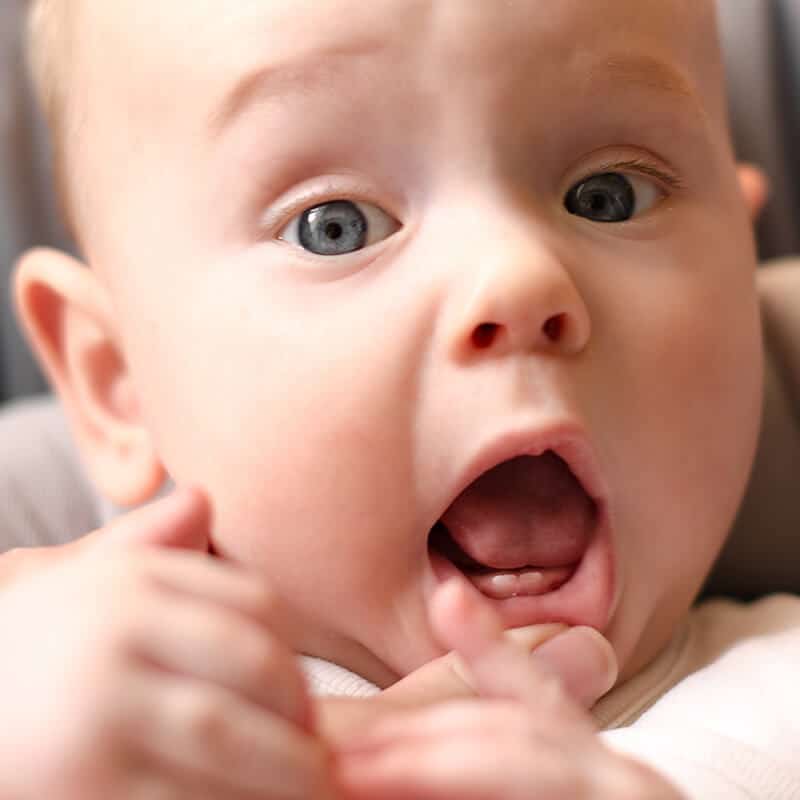
If your baby was premature, their teeth will likely take longer to start coming through.
Most babies have a complete set of 20 baby teeth (or milk teeth) by 30 months/ 2 and a half years old.
What Do Teething Gums Look Like?
Teething gums are red, swollen and inflamed. As the tooth starts to cut through the gums, it will look more whitish. If you run your finger over your baby’s gums, you may be able to feel the little bump.
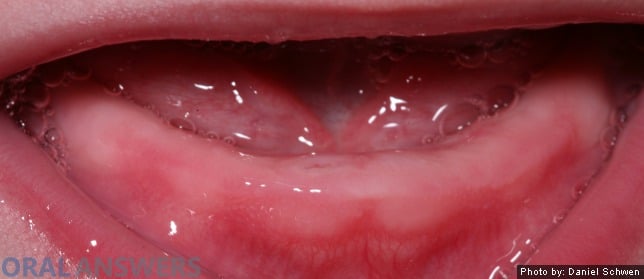
Here is a great picture actually showing the tooth as it cuts through. (Ouchie!)
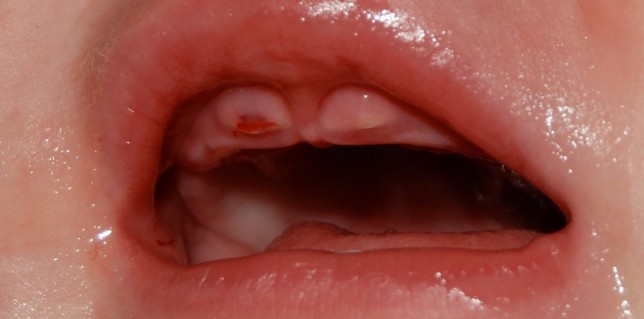
How Long Does Teething Last?
Teething is an ongoing process that usually starts from around 6 months. FORTUNATELY the discomfort of teething really only happens around the time that the tooth is breaking through.
There is no exact timeframe that says how long it takes for a tooth to cut through the gums. Most medical professionals say it takes between 1-7 days per tooth. According to Very Well Family, teething symptoms usually start about four days before your baby’s tooth erupts, and will last for approximately three days after the tooth comes in. The whole teething process is usually complete by the age of two to three.
Doctors say that if your baby is experiencing discomfort for an extended period of time, it is safe to assume it is not from teething. This is a good time to contact your pediatrician.
What Are The Symptoms Of Teething?
How to tell if your baby is teething? There are several symptoms of teething and they’re quite easy to spot. Here’s what you may see:
Your Baby Is Fussy and Irritable
As teeth cut through gums, it is painful and this will make your baby fussy and irritable. 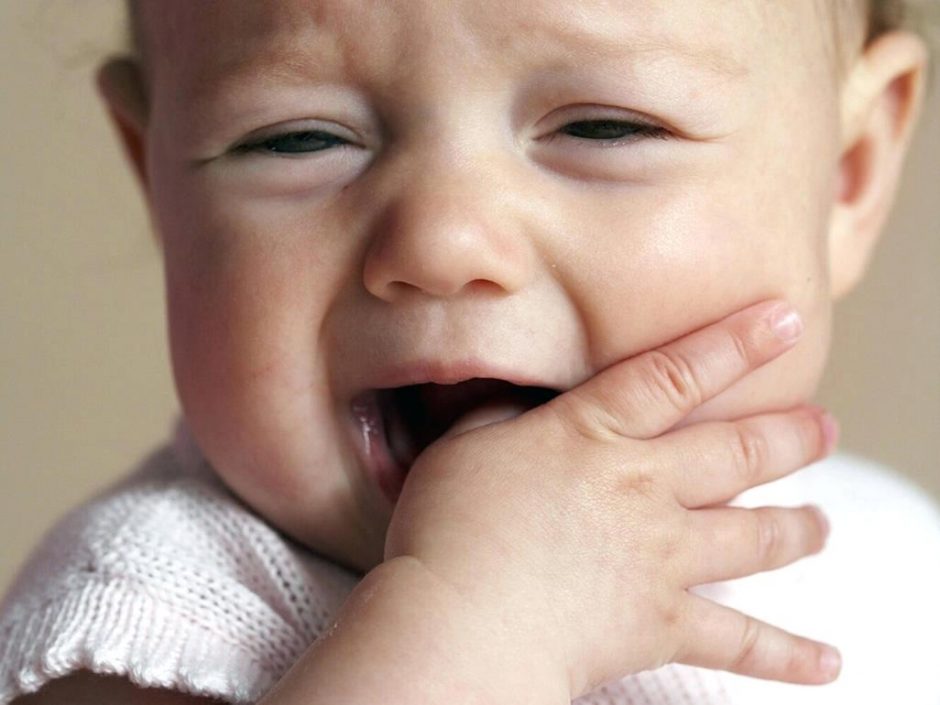
Your Baby Is Not Sleeping Well
This painful process can keep your baby awake at night. If your baby’s sleeping patterns change and he/she is now finding it hard to settle down, he/she could be teething. Pediatricians recommend that you try to stick to your baby’s regular bedtime routine. This offers some sense of comfort if your baby feels unsettled.
Your Baby Is Drooling A Lot More
All babies drool a little – it comes with being a baby. However, teething babies will often have a wet chin and onesie. The extra drool can cause a teething rash. Wipe it down often with a gentle cloth, and put on a bit of baby moisturizer![]() or vaseline for extra protection.
or vaseline for extra protection.
Your Baby Has Red/ Flushed Cheeks Or Chin
Rosy-red cheeks and/or chin are a common sign of teething. This can happen if the tooth is causing irritation.
Your Baby Has Red, Swollen Or Bulging Gums
Red, swollen gums are a sure sign of teething. Gently rubbing your clean finger over your baby’s gums may soothe them.
More Chewing And Biting
We all know that babies love putting things in their mouth – it is how they learn. However, it’s different when babies are teething because chewing helps to relieve the pain and pressure of teething.
If your baby has fingers in the mouth all the time, one quick and easy solution is to try to keep their hands clean. But if your baby started to nibble and bite on things, offer a teething toy![]() to help soothe his/her gums.
to help soothe his/her gums.
Your Baby Is Rejecting Food
When your baby’s gums are sore and swollen, sucking can be painful. Many teething remedies not only help to soothe your baby’s irritated gums, but it also feeds them.
*PLEASE NOTE:* If your child has a few of these teething symptoms, he/she is probably teething, but that may not be the only cause. If you feel unsure, check with your pediatrician.
In What Order Do Baby Teeth Come In?
When it comes to the order that baby teeth come out, there is a wide range of normal. For most babies, the bottom front teeth (central incisors) come out first (6 to 10 months,) but it is also normal for the top front teeth (upper central incisors) to come in around the same time, (8 to 12 months.)

Normally…
- Lower Central Incisors are the first teeth to come at around 6 to 10 months;
- Upper Central and Lateral Incisors follow at around 8 to 13 months of age. Around 13 months, all the incisors have grown in.
- Upper and Lower First Molars follow, (not the canines.) They usually come out around 14 to 19 months of age.
- Upper and Lower Canines start to come in while the first molars are growing. It is not uncommon for the upper and lower canines to follow each other within a month or so at around 16 to 23 months of age.
- Upper and Lower Second Molars are the last set of teeth to grow in. You can expect them around 23 to 33 months. Finally, it is the end of the teething process for your baby.
How To Soothe A Teething Baby At Night?
Many parents complain that their teething baby won’t sleep. Your baby may seem more bothered by teething discomfort at night. This is because there are fewer distractions. The lack of distractions at night may make the pain more noticeable for your baby.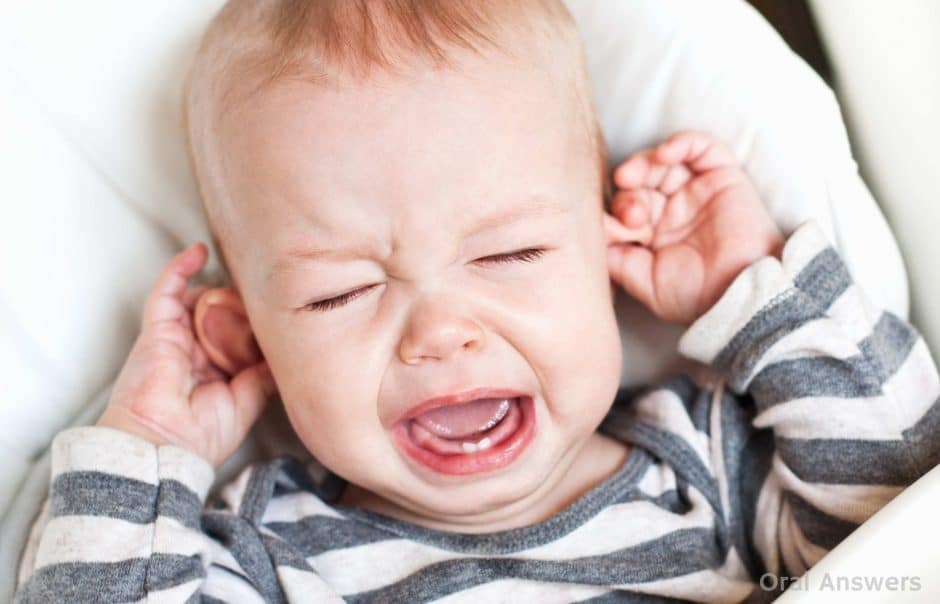
Rubbing your baby’s gums or having your baby chew on a teether![]() is helpful, particularly during the day. However, even though teething remedies like these are effective during the day, they become unsustainable at night because your baby (and you) will want to sleep. If your baby is older than 6 months, pediatricians recommend infant pain medicine
is helpful, particularly during the day. However, even though teething remedies like these are effective during the day, they become unsustainable at night because your baby (and you) will want to sleep. If your baby is older than 6 months, pediatricians recommend infant pain medicine![]() . This will allow your baby to sleep while the medicine is in their system, (usually 3-5 hours). Do check with your pediatrician before you offer medication.
. This will allow your baby to sleep while the medicine is in their system, (usually 3-5 hours). Do check with your pediatrician before you offer medication.
Does Teething Cause Diarrhea?
The increased saliva that is produced during teething can cause your baby’s poops to become slightly loose – this according to the Children’s Hospital of Los Angeles. However, do keep in mind that diarrhea can be a sign of a more serious infection. Do call your pediatrician if your baby’s poops become watery because your baby could be at risk for dehydration. This is especially important if the diarrhea is accompanied by vomiting or a high fever.
How Do I Choose Teethers For My Baby?
Teething toys are great because they help alleviate the pain and discomfort your baby is feeling. When your baby bites and chews on it, it puts pressure on those irritated gums, and that feels good for your baby. But obviously, not every toy is a teething toy. Here’s what to look for:
- Avoid plastic teething rings with liquids inside them. Over the past few years, these kinds of teethers have gotten a bad name because of recalls. There is the potential that bacteria may be growing in liquid and there is always the possibility of a baby biting through the ring and into the liquid. Instead, choose rubber or silicone teething toys
 that are solid.
that are solid. - Avoid teethers that are made of yucky stuff like phthalates and BPA. Instead, go for teethers that are made of food-grade silicone
 .
. - Find teethers that are easy to clean and stays clean and hygienic after a simple wash. Silicone teethers
 are popular because you can quickly wash them under warm water with a little soap. You don’t have to worry about mold growing in areas that you can’t see because silicone teethers are not hollow inside.
are popular because you can quickly wash them under warm water with a little soap. You don’t have to worry about mold growing in areas that you can’t see because silicone teethers are not hollow inside. - Go for baby teethers that are easy to hold. Choose something your baby can easily grab on to and hold for a long time.


- Try to get baby teethers that are textured. The little ridges on the back of the teethers massage their itchy gums and the pressure of biting on it offers instant relief.
- Great teething toys are those that are designed to offer pain relief AND play. This means that your baby is attracted to the colors, the shape, the texture. He/she picks it up, bites on it and can play with it when they are not teething.
- A definite bonus is teethers that can be chilled because cold and pressure (from biting) help to relieve teething pain.
MOM HACK: Try to get a teether that you can attach to a pacifier clip![]() . Babies drop things all the time. Avoid the hassle of needing to wash the teether every 3 minutes by attaching it to your baby’s clothes. That way, he/she has easy access to it whenever they want something to chew on.
. Babies drop things all the time. Avoid the hassle of needing to wash the teether every 3 minutes by attaching it to your baby’s clothes. That way, he/she has easy access to it whenever they want something to chew on.
 Do Teething Necklaces Work?
Do Teething Necklaces Work?
Teething jewelry is awesome because it is made of food-grade silicone. That means it is soft and chewy and safe for babies to chew on.
Teething necklaces are very functional too. They have three uses:
- You’re wearing a teething toy for your baby to chew on. That means you always have easy access to a clean teether;
- Older babies quickly get distracted while nursing. Breastfeeding necklaces
 are perfect for keeping your baby focused on nursing; and
are perfect for keeping your baby focused on nursing; and - If you got a pretty design
 , it will be flattering for you to wear.
, it will be flattering for you to wear.

![]() *PLEASE NOTE*: Teething necklaces are for mom to wear. Do not let your baby wear a teething necklace unless you are closely supervising, and NEVER let your baby sleep with a teething necklace because they are a choking hazard.
*PLEASE NOTE*: Teething necklaces are for mom to wear. Do not let your baby wear a teething necklace unless you are closely supervising, and NEVER let your baby sleep with a teething necklace because they are a choking hazard.
What Are Good Teething Remedies That Actually Work?
There are many over the counter and natural teething remedies to relieve teething symptoms. Below are just a few.
- Massage your baby’s gums with a clean finger. Gently rub the sore areas. The counter pressure offers temporary relief;
- Offer your baby a teething toy. Teether toys
 are safe for your baby to chew on, which helps to soothe their irritated gums;
are safe for your baby to chew on, which helps to soothe their irritated gums; - Offer your baby a clean, damp. cold washcloth. Your baby can chew on it to relieve the discomfort and swelling;
- If your baby is 6 months and older, offer over-the-counter infant pain medicine
 once you’ve checked with your pediatrician. Infant pain medicine is very effective in offering temporary relief;
once you’ve checked with your pediatrician. Infant pain medicine is very effective in offering temporary relief; - Offer your baby a teething popsicle or a momsicle. See teething remedies.
Are Baltic Amber Teething Necklaces Safe?
Baltic Amber teething necklaces and bracelets have become a popular natural teething remedy. Many moms swear by it.
Advocates say that when a baby wears the Baltic amber teething necklace, their body heat triggers the release of a minute amount of oil that contains succinic acid. This is then absorbed into the bloodstream. When that happens, advocates say that the succinic acid from the amber beads works as a natural painkiller.
Supposedly, it also helps to control drooling and improves your baby’s immune system by reducing inflammation in the ears, throat, stomach and respiratory system. But having said all that, there is no medical evidence to substantiate these claims.
*PLEASE NOTE*
- Baltic amber necklaces are a choking and strangulation hazard. They should never be used without your constant supervision, and babies should never sleep with them. There have been deaths associated with strangulation and choking.
- Even though Baltic amber teething necklaces are not meant to be chewed, some babies do try to chew them. This is very risky because if a bead gets chewed off, it poses a choking hazard. This is dangerous because this could be happening while you are watching your baby.
Can I Breastfeed While My Baby Is Teething?
Many babies will want to nurse more often while they are teething because breastfeeding is comforting to them. However, some babies may not want to nurse because sucking can make the pain feel worse.
If this is the case with your baby, you may need to start with a teething remedy. Breastfeeding is considered to be one of many teething remedies because it is soothing for babies, but if your baby is too uncomfortable to suck, you may need to try another teething remedy first before you start nursing.
Is It Normal For Babies To Eat Less While Teething & What Foods To Offer?
Some babies do lose their appetites. They find eating to be uncomfortable when their gums are sore and swollen. But this is not the case for all babies. Some babies may want to eat more often to feel the counter-pressure of food on their gums. This is why some hard vegetables like chilled carrots, celery, cucumber, etc are recommended.
If a hunger or nursing strike persists for a few days, do contact your pediatrician.
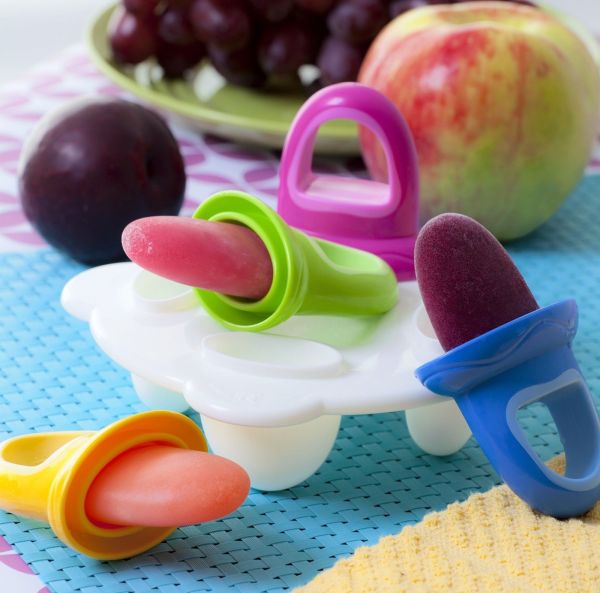
Do Teething Babies Poop More?
If your baby is pooping more often, this may be a coincidence. One reason why teething babies seem to poop more is that the time that babies start solids, is often the same time when babies start teething. It is the addition of the solid foods that make it seem like your baby is pooping more.
What Is A Teething Rash And How Do I Deal With It?
When your baby is teething, there is a lot more drool. A teething rash happens when the excessive drool irritates the sensitive skin around your baby’s mouth. The rash is also known as a drool rash.
A teething rash happens when food, drool and constant wetness irritates a baby’s skin. When you combine that with frequent rubbing on the skin from wiping with a rough cloth, clothing, hugging, and playing, your baby can develop a persistent, though harmless, rash.
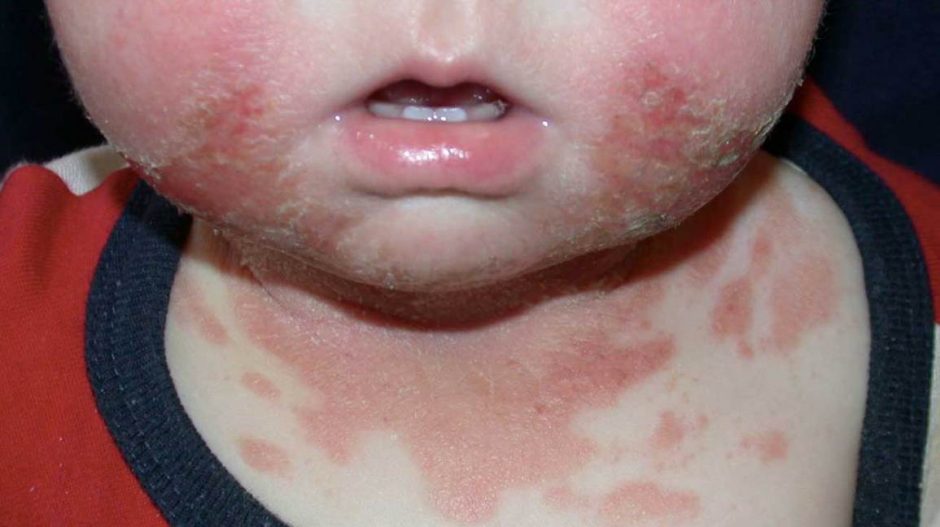
A teething rash can form anywhere drool gathers. This could be on your baby’s cheeks, chin, neck or chest. If your baby is using a pacifier, you might also notice a drool rash on the skin that touches the pacifier.
A teething rash normally causes flat or slightly raised, red patches with tiny bumps. Your baby’s skin may also get a little chapped. Typically, a teething rash can come and go over weeks.
A teething rash can develop at any point. In fact, the teething rash itself does not determine when your baby’s tooth will come out.
To prevent a drool rash, gently wipe off your baby’s chin and mouth from time to time. Use gentle wipes![]() or a gentle washcloth
or a gentle washcloth![]() because harsh cloths or chemicals on wipes can also cause irritation. You may also consider applying a water-based baby moisturizer
because harsh cloths or chemicals on wipes can also cause irritation. You may also consider applying a water-based baby moisturizer![]() to keep your baby’s skin smooth and irritation free.
to keep your baby’s skin smooth and irritation free.
Does Teething Cause Fever?
Some medical professionals say that teething does not cause fever, and it definitely does not cause a high fever.
Others say that teething may cause a low-grade fever of up to 99 F (37.2 C), particularly on the day that the tooth erupts. When in doubt, do not blame your baby’s fever on teething. Coincidences occur often and your baby could be teething and have another illness causing the fever.
When Do I Call My Pediatrician
If your baby has the same symptoms every time he/she gets a new tooth, you can probably blame those symptoms on teething, particularly if those teething symptoms are fairly mild and your baby seems otherwise well.
Teething discomfort can usually be handled at home. If you feel uncertain, call your pediatrician. This is especially important if your baby has a fever, seems particularly uncomfortable or has other signs or symptoms of illness that could be unrelated to the teething.
As was pointed out, teething normally begins at around six months of age. But something else may be happening too. According to the Children’s Hospital of Los Angeles, around 6 months is also the time when a baby’s immunities, (which they received from their mother via the placenta,) are diminishing. When that happens, babies become vulnerable to minor infections. So coincidentally at around 6 months, the symptoms of teething can be confused with a cold or another minor illness.
For example, if your baby has no appetite and is waking up more at night, these seem like teething symptoms. However, if your baby has those symptoms and is pulling on his/her ears, and has a fever, you may have a tooth coming and AND an ear infection. If you feel at all unsure, go see your pediatrician. It is always better to be safe.
When To Start Brushing Baby’s Teeth?
 Dentists recommend that as soon as your baby has a tooth, it’s time to starting caring for it. Tooth decay can affect children of all ages, so it’s a great idea to start early. You can start by wiping your baby’s teeth with a soft cloth or by brushing it with a small, soft baby toothbrush
Dentists recommend that as soon as your baby has a tooth, it’s time to starting caring for it. Tooth decay can affect children of all ages, so it’s a great idea to start early. You can start by wiping your baby’s teeth with a soft cloth or by brushing it with a small, soft baby toothbrush![]() . Gently brush or rub teeth using only water. At this early stage, there is no need to use toothpaste because your baby will swallow it.
. Gently brush or rub teeth using only water. At this early stage, there is no need to use toothpaste because your baby will swallow it.
At around 18 months, start using a pea-sized amount of low-fluoride toothpaste![]() to brush your baby’s teeth twice a day. It may be hard to do, but encourage your baby to spit out toothpaste after brushing.
to brush your baby’s teeth twice a day. It may be hard to do, but encourage your baby to spit out toothpaste after brushing.
HELPFUL RESOURCES FOR MOMS OF TEETHING BABIES
Baby teething can be a bit challenging. Use the resources below to make your life A LOT easier.
